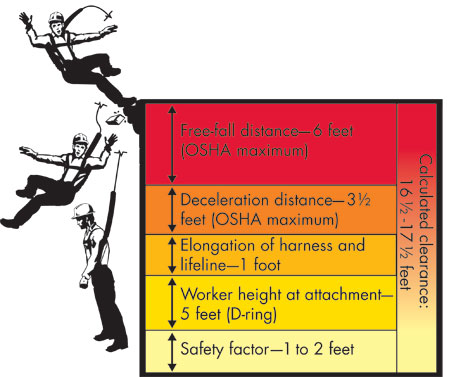Many training resources mention the concept of calculated clearance with personal fall-arrest (PFA) systems. Calculated clearance is the minimum height at which a PFA system will be effective to stop a fall before a worker hits the ground, an obstruction or a lower level.
A PFA system typically consists of a lifeline attached to an anchor point with one end of a rope-grab lanyard connected to the lifeline and the other end connected to a D-ring on the back of a body harness worn by a worker.
A PFA system rigged in fall-restraint mode—adjusted so a worker cannot reach a roof edge—provides the most protection. However, a PFA system that allows worker movement beyond a roof edge operates in fall-arrest mode in the event a worker falls off a roof. This is where calculated clearance comes into play.
Determining calculated clearance for each worker protected by a PFA system is critical for preventing worker injuries. Several components, including free-fall distance, deceleration distance, lifeline and harness elongation, and a safety factor must be considered to determine calculated clearance
Occupational Safety and Health Administration (OSHA) rules regarding PFA system use require that free fall—the act of falling before a PFA system begins to apply force to stop the fall-be limited to 6 feet. Minimizing free-fall distance helps reduce impact forces on a worker.
You also must consider a PFA system's deceleration device, usually a rip-stitch lanyard, which slows the rate of fall and minimizes the impact forces on the worker as the fall is arrested. According to OSHA, a shock-absorbing lanyard must stop a fall within 3 1/2 feet or less.
Additionally, under a fallen worker's impact load, a lifeline will stretch and a harness will be repositioned on the worker at a height higher than the measured height on the worker when no load was present. This amount generally can be assumed to be 1 foot or less.
It also is important to consider anchor point location when determining free-fall distance. The higher the placement of the anchor in relation to the worker's D-ring on his or her harness and the shorter the lanyard, the less the free-fall distance is.

An illustration of how to determine calculated clearance
Roofing workers who use PFA systems that employ a rope-grab on the lifeline often position the rope-grab with a large amount of slack or loose lifeline between the worker's position and the anchor point. This allows for easier movement around a roof but potentially can increase free-fall distance and impact forces on a worker's body when a fall is arrested.
For example, if a roofing worker sets his or her rope-grab 25 feet down the lifeline from the anchor point and moves to a roof edge that is only 15 feet from the anchor point, the free-fall distance experienced will increase 10 feet—the 25 feet of lifeline distance minus the 15 feet of distance from the roof edge to the anchor.
To determine calculated clearance, add to the free-fall distance—including the height of the worker above the working surface (measured at the D-ring)—the maximum 3 1/2 feet of lanyard deceleration distance, harness and lifeline elongation of 1 foot, and 1 to 2 feet of additional height as a safety factor (see figure).
If your workers use PFA systems, ensure they rig and maintain the systems so the distance from the working level on the roof to the ground or any lower level always is greater than the calculated clearance.
Harry Dietz is NRCA's director of risk management.
COMMENTS
Be the first to comment. Please log in to leave a comment.